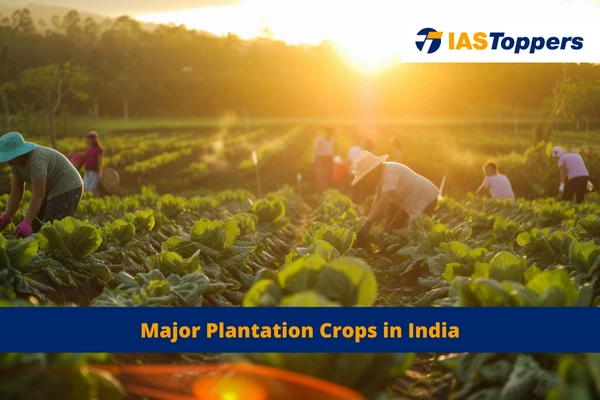Plantation crops, such as tea, coffee, and rubber, encompass high-value crops that are cultivated over extensive areas, making a significant contribution to our economy and representing an essential part of agricultural practices.
Plantation Crops will be helpful for UPSC IAS Exam preparation. GS Paper-3 Indian Economy.
Table of Content
- What are Plantation Crops?
- Importance of Plantation Crops
- Tea
- Coffee
- Difference between cash crops and plantation crops
- Conclusion
- Frequently Asked Questions (FAQs)
What are Plantation Crops?
- Definition: Plantation Crops are crops that are cultivated in a vast area and continuously grown and managed by an individual or a company.
- The crops are perennial and are high-value crops of greater economic importance and play a vital role in our economy.
- List of plantation crops: tea, coffee, rubber, cocoa, betel nut, betel leaf, oil palm, bamboo, etc.
Importance of Plantation Crops
- High-value crops: These are cultivated for their valuable products, commanding a high demand in the market and fetching high prices.
- Global Demand: Numerous countries worldwide export plantation crops due to their high demand in international markets.
- Industrial Significance: Plantation crops undergo processing, which fosters industrial development. For instance, the emergence of tea industries processing tea leaves to produce tea is notable.
- Job Creation: The cultivation of plantation crops necessitates labour throughout the season, offering employment opportunities to numerous individuals. In Kerala, coconut farming, for example, employs 78 man-days per hectare annually. Additionally, the processing industries associated with these crops generate employment for a substantial workforce.
- Soil Erosion Prevention: Crops cultivated on hillsides and slopes, such as tea, play a crucial role in averting soil erosion. They serve as protective cover crops, preventing soil loss caused by rainwater runoff.
Tea
- Tea is a beverage crop grown on plantations.
- Tea is an example of plantation agriculture.
- It was introduced in India initially by the British.
- Tea is a labour-intensive industry.
- It requires abundant, cheap and skilled labour.
- Tea is processed within the tea garden to restore its freshness.
- India is the second largest producer of tea after China.
- Top Tea Producing States in India: Assam > West Bengal > Tamil Nadu.
Climatic Requirements:
- Temperature: Between 20-30°C.
- Rainfall: Around 150-300 cm (high rainfall).
- Soil Type: Deep and fertile well-drained soil, rich in humus and organic matter.
Coffee
- Coffee was brought to Baba Budan Hills from Yemen.
- ‘Arabica’ variety of coffee is produced in India.
- This variety is in great demand all over the world.
- Indian coffee is known in the world for its good quality.
- Top Coffee Producing States in India: Karnataka > Kerala > Tamil Nadu.
Climatic Requirements:
- Temperature: 15-28°C
- Rainfall: 150-250 cm
- Soil Type: Well-drained, deep friable loamy soil.
Difference between cash crops and plantation crops
| Cash Crops | Plantation Crops | |
| Definition | Crops grown for profit | Cultivated in large areas, managed by individuals or companies |
| Contribution to Agricultural Production | Occupies 15% of cropped area, contributes over 40% of agricultural production by value | High-value crops with significant economic importance |
| Examples | Sugarcane, cotton, jute, oilseeds, tobacco, etc. | Tea, coffee, rubber, cocoa, betel nut, betel leaf, oil palm, bamboo, etc. |
| Duration | Annual crops | Perennial crops |
| Economic Role | Contribute to agricultural revenue | Contribute to the overall economy |
Refer to the linked articles to know more about Cash crops and Food Crops.
Conclusion
Plantation crops like tea and coffee, with their unique cultivation requirements and economic significance, have played a crucial role in shaping India’s agricultural landscape, fostering employment opportunities, and establishing the country as a prominent producer in the global market.
Ref:Source-1
| Other Articles in Economy | |
| Cash Crops | Universal Basic Income |
| Minimum Support Price (MSP) in India | Infrastructure investment trusts (InvITs) |
| Monetary Aggregates | Phillips Curve |
FAQs (frequently asked question)
Name any two plantation crops of India.
Tea and Coffee are the two examples of the plantation crops in India.
Is sugarcane a plantation crop?
Yes, sugarcane is a plantation crop.
Is rubber a plantation crop?
Yes, rubber is a plantation crop.
Where rubber is produced in India?
Rubber primarily thrives in Kerala, Tamil Nadu, Karnataka, Andaman and Nicobar Islands, and Meghalaya’s Garo hills, it can also be cultivated in tropical and subtropical regions.
What is the conditional requirement of a rubber plant?
The ideal conditions for rubber growth include a moist and humid climate with rainfall exceeding 200 cm and temperatures above 25°C. India was the fourth-largest natural rubber producer globally in the 2010-11 period.
Is coconut a plantation crop?
Yes, coconut is a plantation crop grown in Kerala, Tamilnadu, Karnataka, Andhra Pradesh, Orissa, Goa, West Bengal, Pondicherry, Maharashtra and Islands of Lakshadweep and Andaman and Nicobar.
is wheat a plantation crop?
No, Wheat is not a plantation crop, it is a cereal crop.
Give Examples of plantation crops.
tea, coffee, rubber, cocoa, betel nut, betel leaf, oil palm, bamboo, etc. are various examples of plantation crops.


